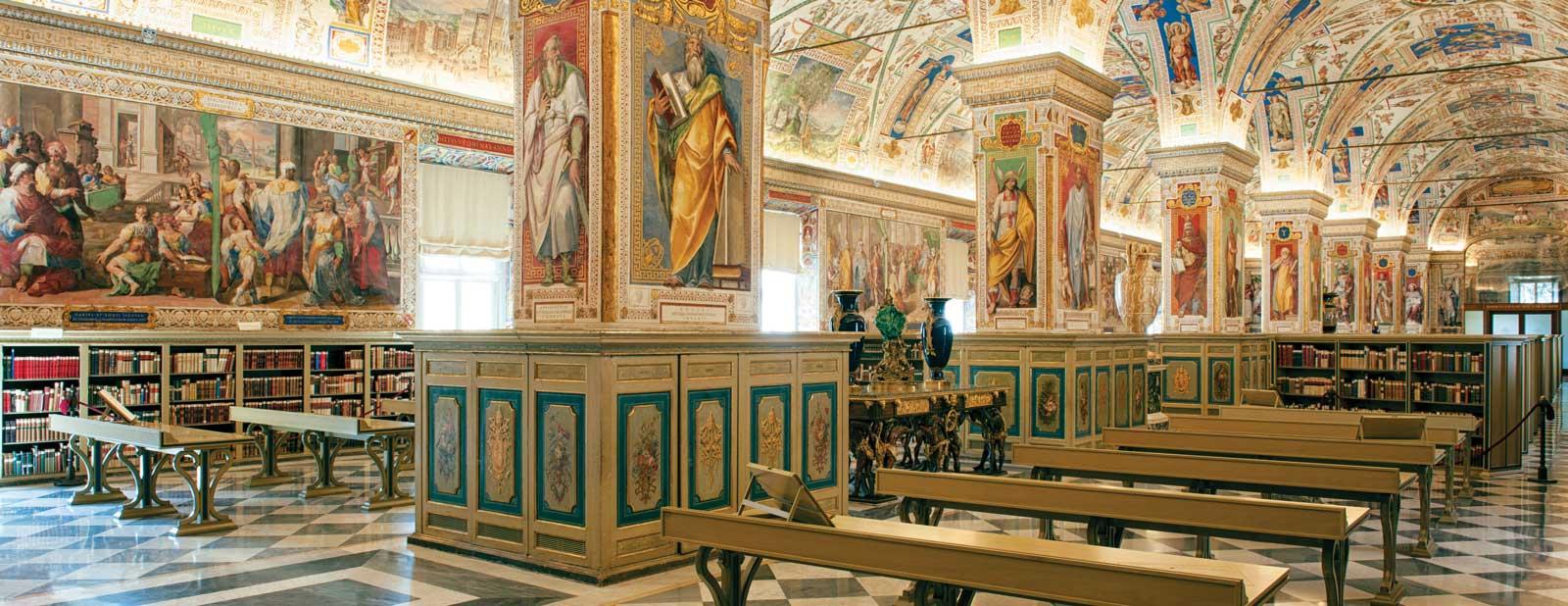Inside, Archbishop Jean-Louis Bruguès heads up two robust institutions, each with its own hierarchy. At age seventy-four the French-born Dominican monsignor appears fit and trim, the large silver cross about his neck starkly contrasting the immaculate black of his clerical waistcoat. He projects vigor, energy, purpose. The library and the archives each has its own prefects and vice-prefects to manage day-to-day affairs, while dozens of librarians, cataloguers, conservators, technicians, and other staff perform all those duties necessary to administer collections of eye-popping depth and breadth.
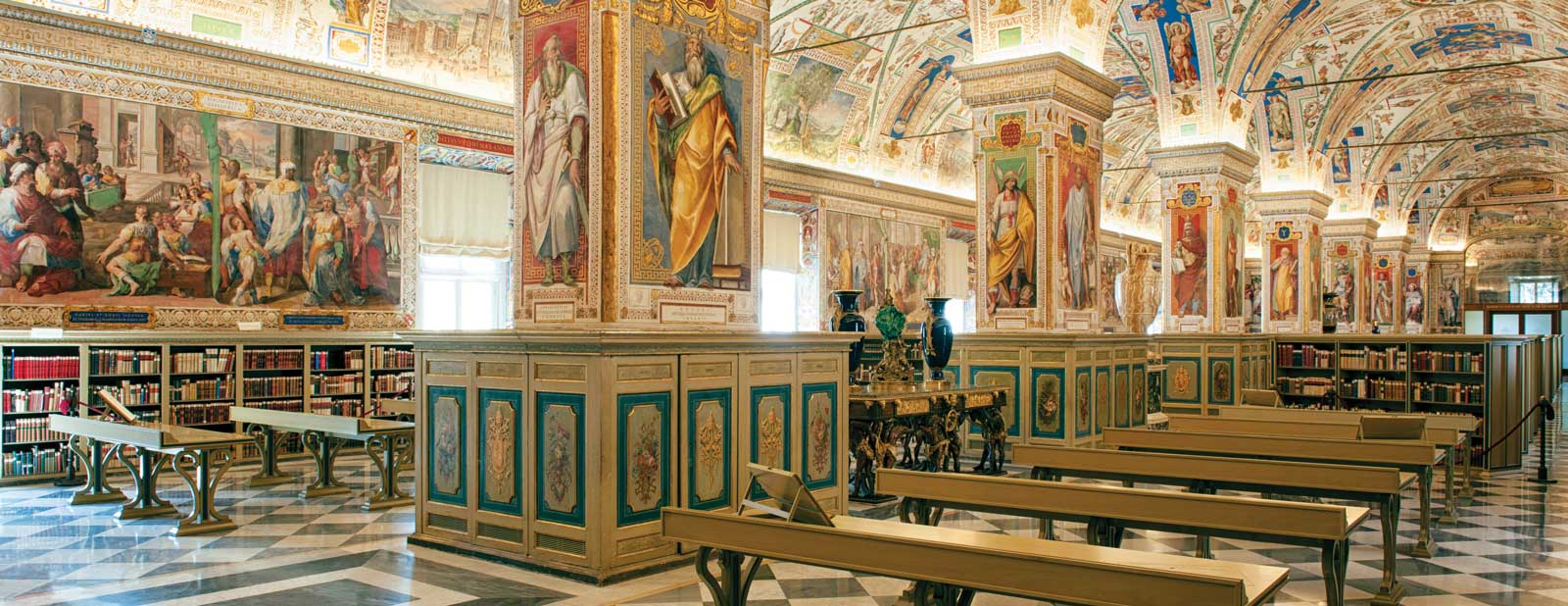
The gorgeous Sistine Hall at the Vatican Library was commissioned by Pope Sixtus V at the end of the sixteenth century. Archbishop Jean-Louis Bruguès, the Vatican Library’s head librarian, said the imagery of the hall represents the “dialogue between faith and reason.”
The Biblioteca Apostolica Vaticana (Vatican Apostolic Library, or “the Vat” to insiders) and the Archivio Segreto Vaticano (Vatican Secret Archives) have reputations as impenetrable fortresses. If you want to meet the pope, attend the open morning mass held every Wednesday and you will perhaps see him for a millisecond as the popemobile makes the rounds of St. Peter’s Square. Want to get into the Vatican Library or Secret Archives? Well… prepare to present some serious scholarly credentials in advance. A letter from a professor won’t open doors as it once did. The process is rigorous. If you’re one of the few thousand researchers annually allowed into the library, the specific materials you require will be brought to your study table. There is no such thing as “browsing the stacks.” And if you’re a journalist, just hope you haven't a deadline looming.
Still, the head librarian of the Vat, who is also the head archivist of the Secret Archives, recently sat for a candid, far-ranging discussion of these two institutions. After obtaining special clearance, entrance to his inner sanctum begins at the Via di Porta Angelica and proceeds through security, where surrendering passports and procuring clip-on visitor passes is protocol. On a workaday Tuesday morning in late March, the football field–sized Belvedere Courtyard is empty but for employee vehicles. A statue of the controversial early theologian St. Hippolytus of Rome, a third-century piece unearthed just outside Rome in the sixteenth century, greets visitors.
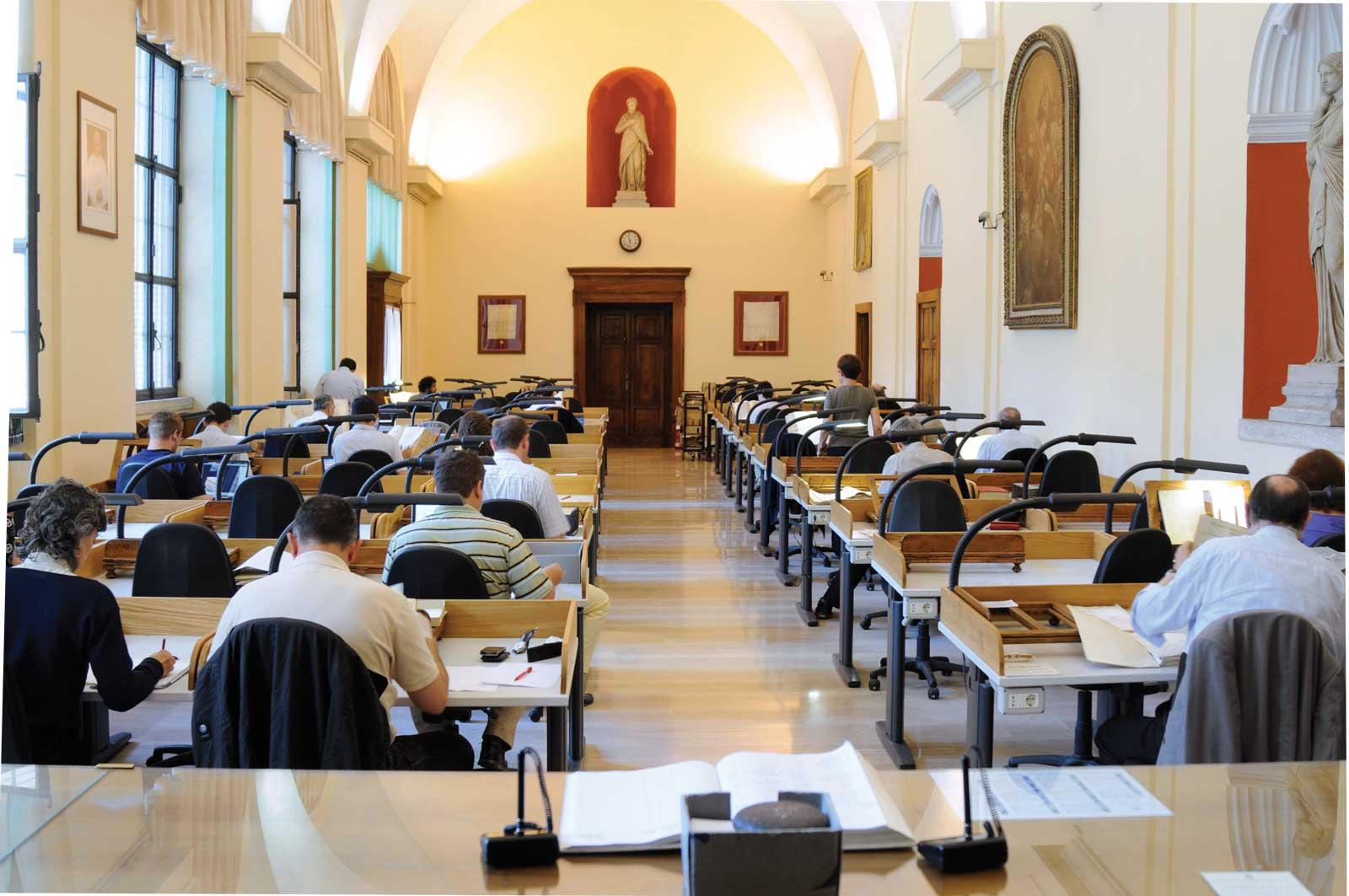
Scholars at work in the main study room of the Vatican Secret Archives.
More than 1.6 million books; 180,000 manuscripts; 8,600 incunabula; 330,000 medals and coins; 150,000 drawings, engravings, and prints; and 150,000 photographs.
The library contains about forty-two miles of shelving which decades ago reportedly held well over two million catalogued items. Those “items” break down into more than 1.6 million books; 180,000 manuscripts; 8,600 incunabula; 330,000 medals and coins; 150,000 drawings, engravings, and prints; 150,000 photographs; and numerous artifacts both sacred (in the museo sacro) and secular (in the museo profane). Its oldest documents date back to the first century. Bruguès’ predecessor, Leonard Boyle, called it “an academic center in the best humanist tradition,” and indeed it houses not only theology but liberal arts and sciences: science, law, history, and philosophy are well represented in every language imaginable, as are specialized fields such as music history and East Asian literature and languages. The archives reportedly contain fifty-three miles of shelving housing 150,000 items organized into more than 650 subject areas—millions of pages of documents, much of it bound into large volumes. The bound catalogue alone fills 35,000 volumes, and that’s a selective, not exhaustive, listing. Its oldest document dates back to the eighth century. There are also schools of library science and paleography, conservation and digitizing laboratories, and much more. (Little known to the public is the fact that the Vatican Library was actually a trailblazer in the late nineteenth century when the developing fields of library science and book and document conservation were in their infancy.)
Bruguès downplays the Vatican’s collection, though, pointing out that, “There is Paris and London and Washington, also very important.” In terms of sheer size, it’s true that the Bibliothèque national de France’s forty million items, the British Museum’s 174 million items, and the Library of Congress’s 164 million items dwarf the Vat. Indeed the Vatican library and archives don’t even make the list of the top twenty largest libraries in the world. Rankings of the best libraries in the world, however, place it near the top of that rarified list.
If the Vatican Library and Secret Archives have a twenty-first-century mission statement, it could be summed up in one word: accessibility. Much of Bruguès’ work appears driven by an overdue realization that if the library and archives intend to thrive, they have to give the appearance—and reality—of relevance and accessibility. It’s as if a papal edict were handed down.
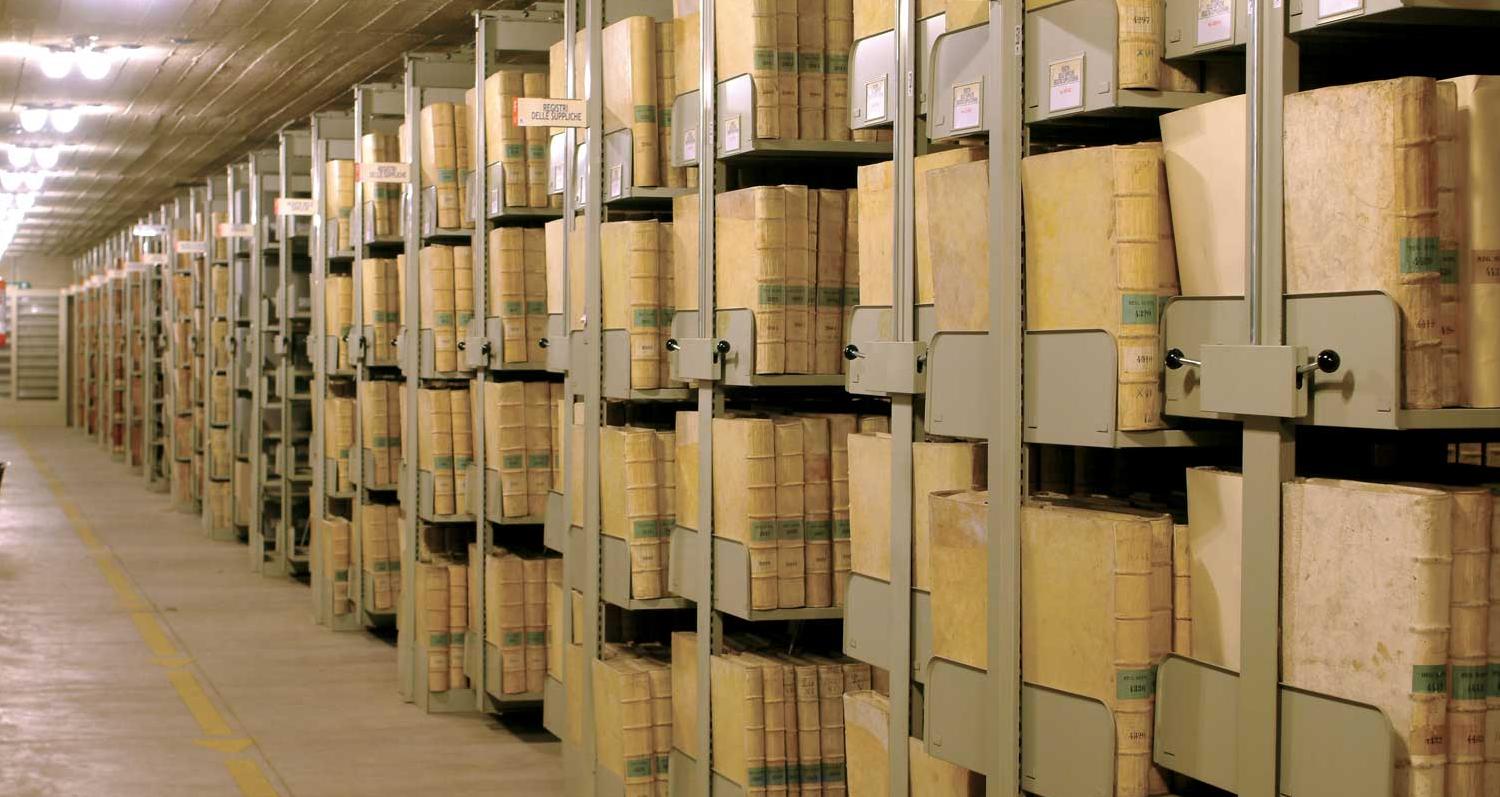
One of the Vatican Secret Archives’ more than six hundred fonds or subject collections, the Registra Supplicationum. According to its catalogue record, “This is one of the largest, best known, and most consulted series in the ASV…. These supplications primarily concern benefices, requests for graces, and matrimonial business.”
Part of their problem is purely linguistic—calling anything “secret” begs conspiracy theorists to let imaginations run wild (à la Dan Brown’s 2000 novel, Angels & Demons). It’s unfortunate that when the Secret Archives was named, the word segreto, from the Latin secretus, meant “private,” “separate,” or “apart,” as well as “secret.” Like any large organization, business, or institution, the archives’ purpose is to house confidential in-house records: internal communications, papal correspondence, state papers, and financial records, many of them going back hundreds of years. (Emails? “Basically, because the Archives also keeps all of the correspondence between the Nunciatures and the Holy See right now it’s impossible to keep all of them,” Bruguès admitted. “There has to be some kind of a screening to see which are the most important ones to keep.”) Add to that a policy of not releasing documents less than seventy-five years old, plus a few other exclusions, and rumors are sure to follow.
In 2012, the Vatican hosted a landmark exhibit at the Capitoline Museums in Rome. Titled Lux in Arcana: The Vatican Secret Archives Reveals Itself, this exhibit of roughly one hundred items marked a huge departure for the famously publicity-shy institution.
In 2012, on the 400th anniversary of the founding of the archives—coincidentally the year of Bruguès’ appointment—the Vatican hosted a landmark exhibit at the Capitoline Museums in Rome. Titled Lux in Arcana: The Vatican Secret Archives Reveals Itself, this exhibit of roughly one hundred items marked a huge departure for the famously publicity-shy institution. Recall, if you will, the single showpiece item from the best museum exhibit you’ve seen. Now imagine one hundred items of the caliber of that single showpiece and you can begin to appreciate the abbondanza of Lux in Arcana.
The exhibit proved an immense triumph, introducing the public to treasures familiar and obscure. Vatican watchers hope it paves the way for more of the same in the future, though Bruguès cautioned, “The Archives, because of the limited personnel, does not have the same ability to organize or to participate in international exhibitions such as the Lux in Arcana exhibition in Rome.” The mile and a half from the archives to the Capitoline Museums they could manage, but to bring it 4,500 miles to the United States or elsewhere wasn’t in the budget. Accessibility is sure to remain an issue for fiscal and other reasons for some time to come, though, and change comes slowly, which is why an Atlantic article recently derided the Secret Archives as “one of the most useless.”
Another issue confronting the archives is the serious logjam of material awaiting cataloguing—an issue that faces almost every archive or special collections department and most antiquarian booksellers. After all, it wasn’t until 2001 that a sixty-foot-long, 700-year-old manuscript known as the “Chinon Parchment” was rediscovered in a drawer of miscellaneous manuscripts. In this intriguing document Pope Clement V absolved the controversial Knights Templar of their many supposed sins. (Ironically this enormous find came to light just before Dan Brown released his Angels follow-up, The Da Vinci Code, with its Knights Templar content, in 2003.)
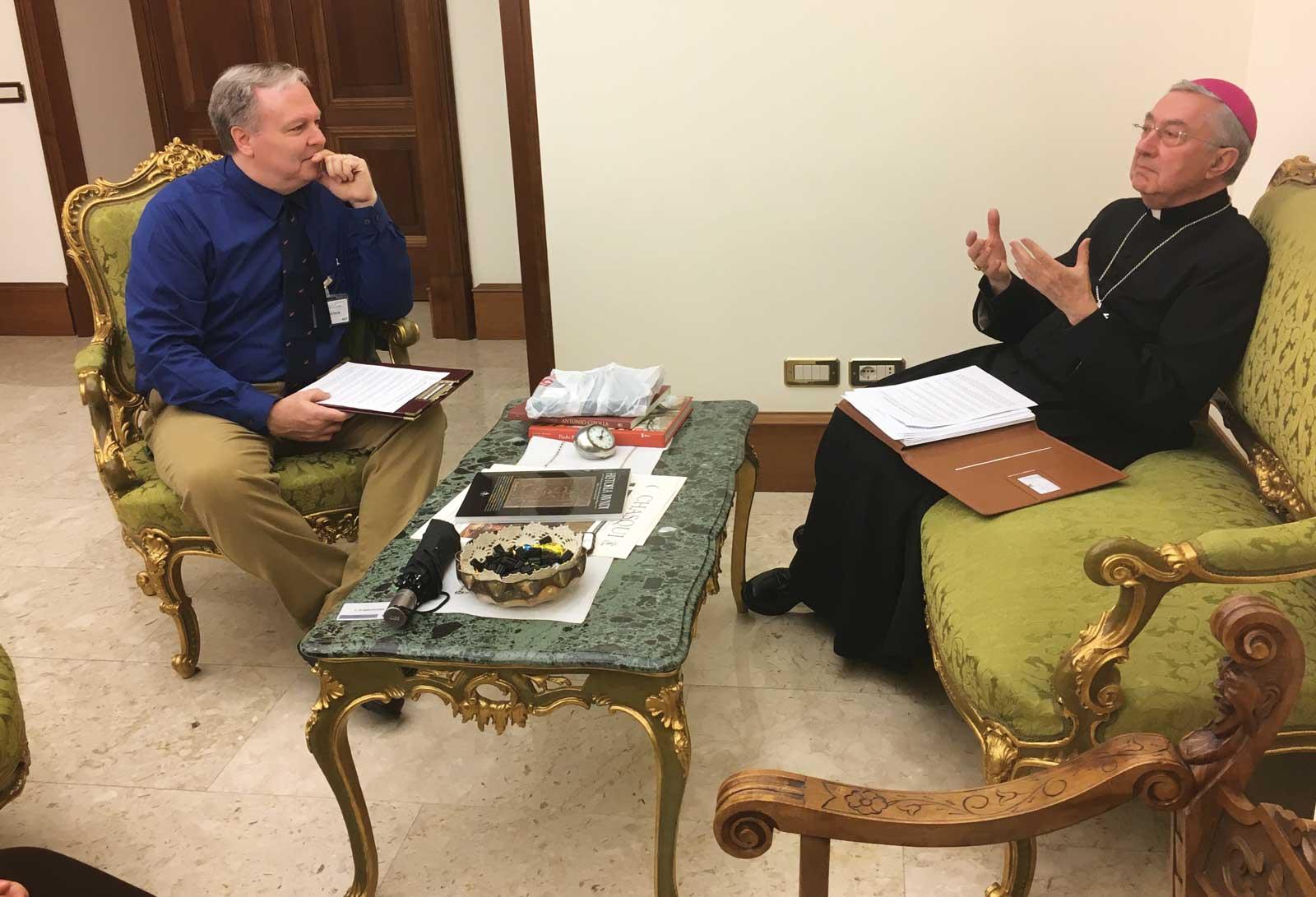
During a recent interview, Archbishop Jean-Louis Bruguès, head librarian of the Vatican Library and head archivist of the Vatican Secret Archives, discussed where these two distinguished institutions are headed under his leadership.
Even with computer wizardry there will likely always be a backlog. “For example, in the archives on the third floor there are tables full of records and archives from the Roman families of the 1700s that haven’t been able to be opened and catalogued because of the lack of personnel…there are still probably treasures both in the archives and the library that we still don’t know,” Bruguès said. Closely related to this issue is the perennial problem that all bibliophiles face: lack of space.
The Vatican Library has never had quite the reputation for unapproachability that haunts the archives. Twenty-five years ago, the Vat held an exhibition at the Library of Congress nearly as spectacular as Lux in Arcana, the well-received Rome Reborn: The Vatican Library and Renaissance Culture. Bruguès clearly wants to do more of this outreach. “We’re really counting on you to do this!” he said with a laugh, for the U.S. would play a large role in making this happen.
“We have been able to start a fruitful relationship with many institutions in the United States,” he explained. “One of them, for example, is the famous University of Notre Dame…. A couple of years ago we had organized, both by the university and us, a symposium together with an exhibit of some material that came from the [Vatican] Library to the University of Notre Dame where directors and other scholars from all over the United States participated. So we were really happy.” That 2016 conference and exhibition at Notre Dame, titled The Promise of the Vatican Library, was the first of what Vatican officials hope will be a series of joint research projects to introduce an American audience to the Vatican Library.
Accessibility in the Internet age really means one thing: digitization. “We have embarked on an adventure, which is the adventure of digitization,” Bruguès remarked, the excitement in his voice unmistakable. “The two advantages of the digitization are conservation and, on the other side, to make available the treasure that is here to a much larger group of people… our richness is in the antique manuscripts. We have about 100,000 manuscripts, antique manuscripts, and so naturally the biggest, the greatest effort of the library is toward the manuscripts. We have decided to digitize only the manuscripts and not the printed books.”
The equalization of access, however, is what most pleases Bruguès. Scholars may need to consult original documents, but there is a bigger world out there. “With the digitization,” he beamed, “we actually are able to reach a much more, let’s say, normal audience than before when just the scholars or people who are studying some particular things would come here for consultation. And with the digitization, we are able to reach a greater public. In this sense we can say that digitization represents a more democratic procedure.”
In addition to digitization, accessibility also means simply opening up the gates. Media tours of the library and archives are notoriously rare and often met with a refusal “because the library is open to scholars and therefore it is not possible to disturb them,” he said. What about the fundraising opportunities that public access and media coverage might bring with it? Bruguès said they have begun to develop an office for fundraising. Qualified, controlled, and limited access would go a long way toward dispelling myths and improving public relations, not to mention raising much-needed funds.
Bruguès’ calming demeanor but forceful manner suggests that Pope Benedict XVI named him Head Librarian and Archivist because he saw him as a “closer” of sorts—someone who gets things done. As the Vatican struggles to remain relevant in the twenty-first century, Bruguès appears on the cusp of pushing through technical advances that have been decades in the making. It may seem like baby steps, but the library and the archives are both many hundreds of years old and they have weighty obligations. “The library represents the cultural memory of the church, and the archives represent the historic memory of the church,” Bruguès’ said.
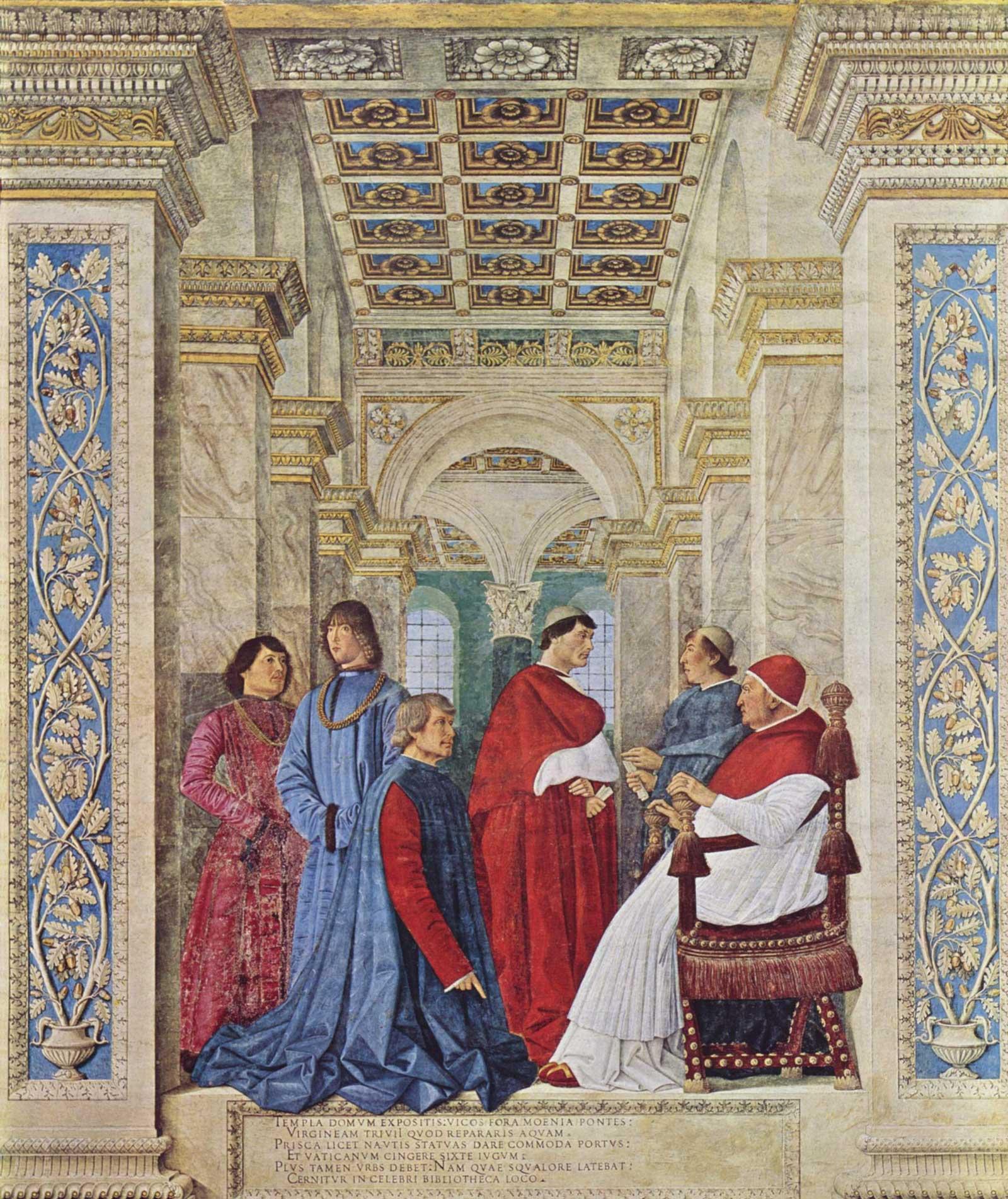
Sixtus IV Appointing Platina as Prefect of the Vatican Library, a 1477 fresco by Melozzo da Forlì celebrating the founding of the Vatican Library by Pope Sixtus IV two years earlier. Transferred to canvas, it is now housed at the Vatican Pinacoteca in Rome.
One might picture Bruguès as a man surrounded by extraordinary treasures, easily attached to certain legendary Vatican artifacts: the transcript of Galileo’s heresy trial, Henry VIII’s saucy love letters to Anne Boleyn, Michelangelo’s letters dunning the Vatican for Sistine Chapel payment, or the Codex Vaticanus, the oldest surviving text of the Greek Bible. But Bruguès names neither book nor manuscript as his favorite. “The main thing in the library is the famous Sistine Hall, which is the library of the 1500s. Because on the left side there are all the libraries of the world. There is the adventure of human reason. On the right side there all the ecumenical councils, the first ones. On that side we have the adventure of religious faith. Because of how it has been put”—here he raises one hand, then the other, back and forth, like a scale seeking balance—“one library, one council, one library, one council, on and on. The whole two walls really represent that dialogue between faith and reason that we cherish now but are well represented then in 1585.”
Does the public truly understand the purpose and function of the Vatican Library and the Secret Archives? Bruguès replied, “It all depends basically on the sensitivity of the public to memory. If the public does not really have, does not cherish, memory, then there is no role of the archives or the library in their society. When the public is richer in their sensitivity to culture—not necessarily rich economically but has that sensibility—then the library and the archives have a role to play.”
He seems keenly aware that young people “especially in Western cultures, have a shrinking training and exposure to history or to anything classic. In Muslim countries, their youth is much more sensitive [to] and trained in their history and the memory that they have to keep. Therefore, the capacity of the population to really embark or look to the future is in their ability to look at their memory, to look at their history.”
Bruguès’ thoughts taper off. “Without memory,” he concluded, “there is no future.”

